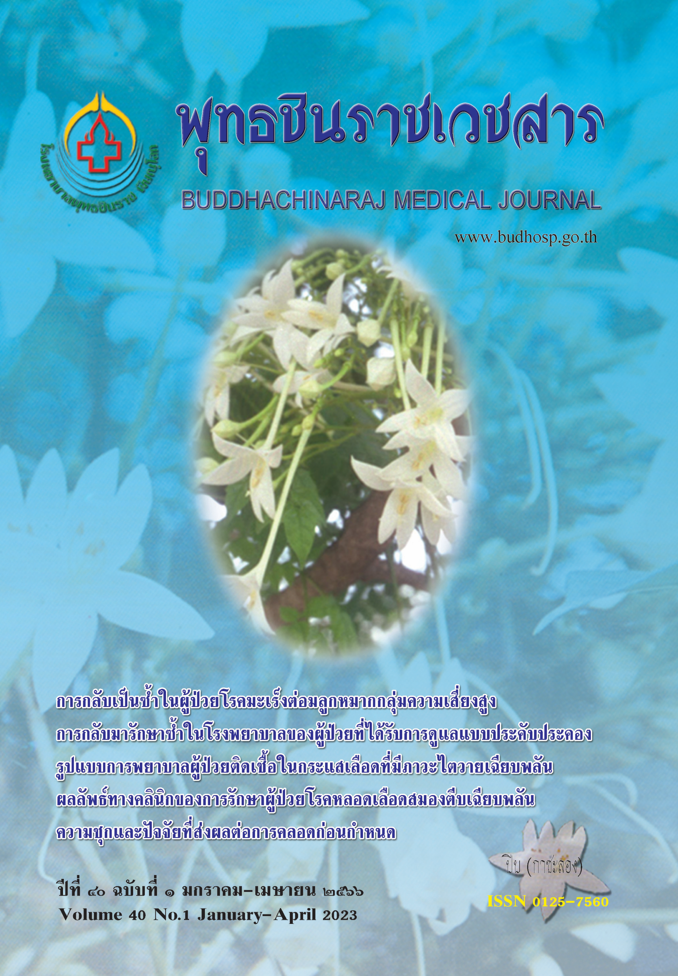การกลับเป็นซ้ำโดยการตรวจทางชีวเคมีในผู้ป่วยโรคมะเร็งต่อมลูกหมาก กลุ่มความเสี่ยงสูงที่เคยได้รับการรักษาตามแนวทางมาตรฐานการรักษาของประเทศไทย
การกลับเป็นซ้ำโดยการตรวจทางชีวเคมีในผู้ป่วยโรคมะเร็งต่อมลูกหมากกลุ่มความเสี่ยงสูง
คำสำคัญ:
มะเร็งต่อมลูกหมากกลุ่มความเสี่ยงสูง, การกลับเป็นซ้ำ, การตรวจทางชีวเคมี, การฉายรังสี, การยับยั้งฮอร์โมนแอนโดรเจนบทคัดย่อ
ในประเทศไทยการรักษาผู้ป่วยโรคต่อมลูกหมากที่มีความเสี่ยงสูงโดยการฉายรังสีร่วมกับการให้ยากลุ่ม GnRH agonist ต้านการสร้างฮอร์โมนเพศชาย 2 ปีเป็นทางเลือกมาตรฐานนอกเหนือจากการผ่าตัด การศึกษาข้อมูลย้อนหลังจากเวชระเบียนแล้วเก็บข้อมูลใหม่ไปข้างหน้าครั้งนี้มีวัตถุประสงค์เพื่อประเมินการกลับเป็นซ้ำของผู้ป่วยจากการตรวจทางชีวเคมีและปัจจัยที่ส่งผลให้กลับเป็นซ้ำหลังได้รับการรักษาด้วยการฉายรังสีและยับยั้งฮอร์โมนแอนโดรเจนครบ 2 ปีในโรงพยาบาลมหาวิทยาลัยนเรศวร โดยศึกษาย้อนหลังแบบ cohort เก็บข้อมูลและวิเคราะห์ระหว่างวันที่ 1 มกราคม พ.ศ. 2556 ถึงวันที่ 31 ธันวาคม พ.ศ. 2564 จำนวน 77 คน ตรวจพบการกลับเป็นซ้ำ 6 คน (ร้อยละ 7.8) มีอัตรารอดชีพที่ 24 เดือนร้อยละ 97.2 และอัตรารอดจากการกลับเป็นซ้ำที่ 36, 48, 60 เดือนเท่ากับร้อยละ 94.1, 81.3, 61 ตามลำดับ ปัจจัยที่ส่งผลให้การกลับเป็นซ้ำ ได้แก่ ค่า PSA ก่อนฉายรังสี ≥ 20 นก./มล. (p = 0.038) ความเข้มข้น PSA > 0.5 นก./มล./มล. (p = 0.025) และ Gleason score ≥ 8 (p = 0.004) สรุปได้ว่าผู้ป่วยโรคมะเร็งต่อมลูกหมากกลุ่มความเสี่ยงสูงที่ได้รับการฉายรังสีและยายับยั้งฮอร์โมนแอนโดรเจนครบ 2 ปีพบการกลับเป็นซ้ำร้อยละ 7.8 และปัจจัยที่ส่งผลต่อการกลับเป็นซ้ำอย่างมีนัยสำคัญทางสถิติ ได้แก่ Gleason score ≥ 8, PSA ก่อนฉายแสง ≥ 20 นก./มล. และความเข้มข้น PSA > 0.5 นก./มล./มล. ดังนั้นควรสนับสนุนการรักษาหลายรูปแบบร่วมกับทีมสหสาขาวิชาชีพ
เอกสารอ้างอิง
Siegel RL, Miller KD, Wagle NS, Jemal A. Cancer statistics, 2023. CA Cancer J Clin 2023;73(1):17-48.
International Agency for Research on Cancer (WHO). Thailand cancer fact sheets 2020. [Internet]. 2021 March [cited 2023 March 2]. Available from: https://gco.iarc.fr/today/data/factsheets/populations/764-thailand-fact-sheets.pdf
Epstein JI, Egevad L, Amin MB, Delahunt B, Srigley JR, Humphrey PA; Grading Committee. The 2014 International Society of Urological Pathology (ISUP) Consensus Conference on Gleason Grading of Prostatic Carcinoma: Definition of Grading Patterns and Proposal for a New Grading System. Am J Surg Pathol. 2016 Feb;40(2):244-52.
D'Amico AV, Whittington R, Malkowicz SB, Schultz D, Blank K, Broderick GA, et al. Biochemical outcome after radical prostatectomy, external beam radiation therapy, or interstitial radiation therapy for clinically localized prostate cancer. JAMA 1998;280(11):969-74.
Hernandez DJ, Nielsen ME, Han M, Partin AW. Contemporary evaluation of the D'amico risk classification of prostate cancer. Urology 2007;70(5):931-5.
National Comprehensive Cancer Network. Prostate cancer (Version1.2022) [Internet]. 2021 April [cited 2021 April 11]. Available from: https://www.nccn.org/professinals/physician_gls/pdf/ prostate.pdf
Kupelian PA, Buchsbaum JC, Elshaikh M, Reddy CA, Zippe C, Klein EA. Factors affecting recurrence rates after prostatectomy or radiotherapy in localized prostate carcinoma patients with biopsy Gleason score 8 or above. Cancer 2002;95(11):2302-7.
Manorom D, Pripatnanont C, Siraprapasiri P, editors. Guideline for screening diagnosis and management of prostate cancer. Bangkok, Thailand: Kosit Press Company Limited; 2017.
Roach M, Hanks G, Thames H, Schellhammer P, Shipley WU, Sokol GH, et al. Defining biochemical failure following radiotherapy with or without hormonal therapy in men with clinically localized prostate cancer: recommendations of the RTOG-ASTRO Phoenix Consensus Conference. Int J Radiat Oncol Biol Phys 2006;65(4):965-74. doi: 10.1016/j.ijrobp.2006.04.029
Saad A, Goldstein J, Lawrence YR, Spieler B, Leibowitz-Amit R, Berger R, et al. Classifying high-risk versus very high-risk prostate cancer: is it relevant to outcomes of conformal radiotherapy and androgen deprivation? Radiat Oncol 2017;12(1):5. doi: 10.1186/s13014-016-0743-2
Gunnarsson O, Schelin S, Brudin L, Carlsson S, Damber J-E. Triple treatment of high-risk prostate cancer. A matched cohort study with up to 19 years follow-up comparing survival outcomes after triple treatment and treatment with hormones and radiotherapy. Scand J Urol 2019;53(2–3):102–8.
Wang Z, Ni Y, Chen J, Sun G, Zhang X, Zhao J et al. The efficacy and safety of radical prostatectomy and radiotherapy in high-risk prostate cancer: a systematic review and meta-analysis. World J Surg Oncol 2020;18(1):42. doi: 10.1186/s12957-020-01824-9
Leal-García M, Canto P, Cárdenas-Cárdenas E, Feria-Bernal G, García-García E, Méndez JP. Overweight and obesity in men with prostate cancer do not constitute risk factors for biochemical recurrence. Aging Male 2020;23(5):1283-8.
Xu H, Zhu Y, Dai B, Ye DW. National Comprehensive Cancer Network (NCCN) risk classification in predicting biochemical recurrence after radical prostatectomy: a retrospective cohort study in Chinese prostate cancer patients. Asian J Androl 2018;20(6):551-4.
Rosser CJ, Kuban DA, Levy LB, Chichakli R, Pollack A, Lee AK, et al. Prostate specific antigen bounce phenomenon after external beam radiation for clinically localized prostate cancer. J Urol 2002;168(5):2001–5.
ดาวน์โหลด
เผยแพร่แล้ว
ฉบับ
ประเภทบทความ
สัญญาอนุญาต
ลิขสิทธิ์ (c) 2023 ``โรงพยาบาลพุทธชินราช พิษณุโลก

อนุญาตภายใต้เงื่อนไข Creative Commons Attribution-NonCommercial-NoDerivatives 4.0 International License.






